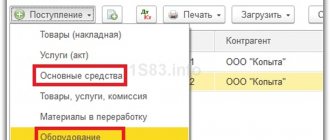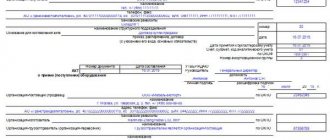Power of attorney
An employee whose authority is confirmed by a power of attorney can receive purchased goods or accept work or services.
It can be written out using standardized forms No. M-2 or No. M-2a. They were approved by Decree of the State Statistics Committee of Russia dated October 30, 1997 No. 71a. The forms of these powers of attorney are essentially the same, the only difference is that form No. M-2 has a spine. It is needed to record powers of attorney in the registration journal. Whether to keep such a journal or not is up to everyone to decide for themselves. If you don’t, then it’s easier to use form No. M-2a.
Situation: is it possible to issue an M-2 power of attorney to a citizen who is not an employee of the organization?
Answer: yes, you can.
The instructions approved by Resolution of the State Statistics Committee of Russia dated October 30, 1997 No. 71a provide that a power of attorney in form No. M-2 can only be issued to employees of the organization. However, the Resolution of the Presidium of the Supreme Arbitration Court of the Russian Federation dated August 13, 1996 No. 1792/96 states: from the moment the first part of the Civil Code of the Russian Federation came into force (from January 1, 1995), powers of attorney on behalf of a legal entity are drawn up taking into account the requirements of Article 185 of the Civil Code of the Russian Federation. This norm allows the right to issue a power of attorney to any person, and not just an employee (clause 1 of Article 185 of the Civil Code of the Russian Federation).
In addition, there is no prohibition on giving cash on account to a person working under a civil contract. And the accountant needs a power of attorney to receive goods and materials.
Thus, current legislation allows the issuance of a power of attorney to receive goods and materials to people who are not employees of the organization.
Similar conclusions follow from the decision of the Supreme Court of the Russian Federation dated June 6, 2011 No. GKPI11-617.
Instead of standardized ones, you can also use forms developed independently. The main thing is that the document contains all the necessary details. Whatever form you use, it is first approved by the manager with an order to the accounting policy.
This is provided for by Part 2 of Article 9 of the Law of December 6, 2011 No. 402-FZ and paragraph 4 of PBU 1/2008.
Set the validity period of the power of attorney depending on the possibility of receiving and exporting the relevant valuables according to the order, invoice, invoice or other document replacing them. However, the maximum and minimum terms of validity of a power of attorney are not established by law. If this period is not specified in the power of attorney, then it will be valid for one year from the date of issue (clause 1 of Article 186 of the Civil Code of the Russian Federation).
Situation: is it necessary to issue a power of attorney to an accountable person in order for him to act on behalf of the organization?
Answer: no, not necessarily. The legislation does not contain such a requirement.
However, if you do not issue a power of attorney to the employee, the organization may have problems receiving an invoice. It is this document that serves as the basis for deducting VAT on goods (work, services) purchased through an employee (clause 1 of Article 172 of the Tax Code of the Russian Federation).
Difficulty in obtaining an invoice may arise because when selling for cash, retailers have the right not to issue invoices, but to limit themselves to cash receipts (Clause 7, Article 168 of the Tax Code of the Russian Federation). Acting without a power of attorney, an employee of an organization acts as an ordinary person purchasing things for personal use. Therefore, the seller is not obliged to issue him an invoice.
But if the employee presents a power of attorney from the organization, the supplier will have to issue an invoice. In this case, the employee will act on behalf of the organization, and the seller will have the obligation to issue the required document (Clause 3 of Article 168 of the Tax Code of the Russian Federation).
This position is set out in the letter of the Ministry of Taxes and Taxes of Russia dated October 10, 2003 No. 03-1-08/2963/11-AL268.
Report on imprest amounts
Within three days from the end of the period for which the advance was issued, the employee is required to report on the money spent. To do this, he must submit an advance report to the accounting department in the unified form No. AO-1 or in a form developed by the organization independently. The main thing is that the document contains all the necessary details. Whatever form you use, it is first approved by the manager with an order to the accounting policy.
This procedure follows from paragraph 6.3 of the Bank of Russia directive No. 3210-U dated March 11, 2014, part 2 of Article 9 of the Law dated December 6, 2011 No. 402-FZ and paragraph 4 of PBU 1/2008.
Situation: is it possible to prepare an advance report once at the end of the month? During the month, cash is issued for reporting to the same employee several times (for example, on the 5th and 15th).
Answer: no, you can't.
You can issue cash against an account provided that the employee has accounted for the advance received previously. When drawing up one advance report for all accountable amounts issued during the month, this requirement is not met. This follows from paragraph 6.3 of the Bank of Russia Directive No. 3210-U dated March 11, 2014 and paragraph 214 of the Instructions to the Unified Chart of Accounts No. 157n.
Attention: if tax inspectors discover that an organization has unlawfully issued money on account (an employee has not yet reported on previously issued amounts), then they may try to fine it for violating the Rules for Conducting Cash Transactions.
However, liability for this offense occurs in strictly limited cases. They are specified in Article 15.1 of the Code of the Russian Federation on Administrative Offenses. Failure to comply with the rules for issuing imprest amounts does not apply to them. It turns out that there is no fine for such an offense. This is confirmed by arbitration practice (see, for example, decisions of the Federal Antimonopoly Service of the North-Western District dated February 21, 2005 No. A56-33543/04 and dated February 9, 2005 No. A21-8287/04-C1).
On the front side of the report, the employee indicates his last name and initials, profession (position), purpose of the advance, etc. On the back side, he must reflect all expenses incurred by him. The employee attaches the received supporting documents to the advance report and numbers them in the order in which they are recorded in the report.
Situation: should an employee issue an advance report if he has returned the entire accountable amount received?
Answer: no, you shouldn't.
The advance report serves as the basis for writing off expenses that the organization incurred through an employee (instructions approved by Resolution of the State Statistics Committee of Russia dated August 1, 2001 No. 55).
If the employee has returned the entire amount given to him on account, no expenses arise.
For the amount received, draw up a cash receipt order, form No. KO-1. In the “Base” line of this document, write: “Return of unused accountable amounts.”
Checking the expense report
When you receive an advance report, fill out a receipt (a detachable part of the report) and give it to the employee. It is needed to confirm that the report has been accepted for verification. And the check is as follows.
First, control the targeted spending of money. To do this, look at the purposes for which the employee received money from the organization. These data are indicated in the document that served as the basis for issuing accountable amounts. For example, in a cash receipt order, order, statement, etc. Then compare the goal with the result according to the documents that the employee attached to his report. If they match, it means the money was used for its intended purpose.
Secondly, make sure that you have supporting documents that confirm the expenses, and also check that they are correctly prepared and the amounts are calculated.
If the employee paid in cash, proof of expenses may be a cash receipt, a receipt for a cash receipt order, or a strict reporting form. And when making payments by bank card - original slips, receipts from electronic ATMs and terminals. The amounts spent by the employee according to the report must correspond to the amounts indicated in the payment documents.
Situation: is it possible to accept only a receipt for a cash receipt order (without a cash register receipt) as confirmation of expenses of an accountable person?
Answer: yes, you can.
The employee can attach to the advance report a receipt for the cash receipt order issued by the counterparty (without a cash register receipt). Such a document also confirms that the employee incurred out-of-pocket expenses.
Tax inspectors often require that a cash receipt be attached to the advance report as the main supporting document (see, for example, letter of the Department of Tax Administration of Russia for Moscow dated August 12, 2003 No. 29-12/44158). But this requirement is not confirmed by legal norms. Cash order form No. KO-1 is one of the forms of primary accounting documentation. Therefore, the receipt issued for it is the same supporting document as a cash receipt. This conclusion is confirmed by arbitration practice (see, for example, Resolution of the FAS Moscow District dated December 9, 2005 No. KA-A40/12227–05).
“1C: Accounting 8” (rev. 3.0): how to register the purchase of an operating system through an accountable person (+ video)?
Organization on OSNO. Funds were transferred to the accountable person's card to purchase a mobile phone. The accountable person purchased a phone worth RUB 102,391.00. (including VAT RUB 17,065.17) and provided a cash receipt. In “1C: Accounting 8” edition 3.0, how can I purchase a phone for an organization through an accountable person?
The video was made in the program “1C: Accounting 8” version 3.0.73.50.
To purchase inventory items, an organization can issue cash to employees on account, and also transfer accountable amounts to bank cards, including “salary” cards (see letters of the Ministry of Finance of Russia dated August 25, 2014 No. 03- 11-11/42288, dated 07/21/2017 No. 09-01-07/46781).
The name of the product is included in the mandatory details of the cash receipt (Article 4.7 of the Federal Law of May 22, 2003 No. 54-FZ “On the use of cash register equipment when making payments in the Russian Federation”). Since the name of the purchased product is indicated on the cash receipt issued to the buyer, the organization engaged in retail trade is not obliged to issue a sales receipt (letter of the Federal Tax Service of Russia for Moscow dated April 26, 2011 No. 17-15/041152). Thus, an organization can accept purchased inventory items for accounting on the basis of an advance report and a cash receipt. A receipt is sufficient to document expenses for income tax purposes.
For a recommendation article that explains in detail whether VAT can be deducted if goods are purchased by an employee using a cash receipt without an invoice, see 1C:ITS in the “Value Added Tax” reference book in the “Legislative Consultations” section.
In "1C: Accounting 8" in the document Advance report
On the
Advances
, you should indicate the document written off from the current account, which reflected the employee’s receipt of funds for the report.
Receipt of goods and materials is registered on the Goods tab.
In the tabular part, you should indicate the details of the check, phone name, quantity, cost, VAT rate.
The VAT amount allocated on the check must be indicated in the VAT
.
Since an invoice has not been received from the supplier, the SF
should be disabled.
If there is no invoice,
the Supplier field Since the purchased phone meets the criteria of a fixed asset (FA) (clause 4 of PBU 6/01 “Accounting for fixed assets”, approved by order of the Ministry of Finance of Russia dated March 30, 2001 No. 26n), then in the Accounting account
you should indicate account 08.04.1 “Acquisition components of fixed assets."
In the VAT Account
, you should indicate account 19.01 “VAT on the acquisition of fixed assets.”
When posting the document Advance report
the VAT amount will be automatically written off to the debit of account 91.02 “Other expenses” under the article
Write-off of allocated VAT for other expenses
(this article is a predefined element of the directory
Other income and expenses
).
In the card of the article Write-off of allocated VAT for other expenses,
the flag
Accepted for tax accounting is
disabled
.
A fixed asset acquired through an advance report is accepted for accounting using the document Acceptance for accounting of fixed assets
with the operation type
Equipment.
In the header of the document you should fill in the location of the OS and the financially responsible person (MRP). Then you should sequentially fill out all the bookmarks of the document.
On the Non-current asset
indicates the method of receipt (
Purchase for a fee
), name of the object (phone name), accounting account (08.04.1), warehouse (must correspond to the warehouse specified in the
Advance report
).
On the Fixed Assets
Click the
Add
to go to the
Fixed Assets
, enter a new object and fill out information about the fixed asset being created.
Accounting tab
filled in as follows:
- in the Method of reflecting depreciation expenses
from the
Methods of reflecting expenses
, you should select a method or create a new method, indicating the cost account and analytics where the depreciation expenses of the object will be included; - in the Useful life (in months)
, you should indicate the period in months for accounting purposes; - the remaining fields are filled with default values.
On the Tax Accounting
in the field
Procedure for including value in expenses,
you should select the value
Inclusion in expenses when accepted for accounting
, since in tax accounting property worth less than 100,000 rubles. is not recognized as depreciable (clause 1 of article 256, clause 1 of article 257 of the Tax Code of the Russian Federation).
Starting next month, the phone will begin to be depreciated only in accounting.
Documentary proof of purchases
In addition to payment documents, the employee must attach documents confirming the purchase to the advance report. For example, these could be sales receipts, invoices, certificates of work performed (services rendered), etc.
If an employee acquired property (fixed assets, materials, goods), work or services for the organization, then the fact of their receipt (like any other fact of economic life) must be confirmed by a primary accounting document (Part 1 of Article 9 of the Law of December 6, 2011 No. 402-FZ). This document must come from the supplier.
If there is no such document, then draw it up yourself (for example, when receiving materials without documents, draw up a report in free form or in form No. M-7 (Resolution of the State Statistics Committee of Russia dated October 30, 1997 No. 71a)). It should be borne in mind that a document drawn up in any form must contain all the mandatory details provided for in Part 2 of Article 9 of the Law of December 6, 2011 No. 402-FZ.
Situation: is it possible to accept an employee’s advance report for the purchase of materials if only a cash receipt is attached to it (without a sales receipt or invoice)?
Answer: yes, you can.
But to do this, you need to independently draw up an additional document confirming the receipt of valuables (see, for example, the resolution of the Federal Antimonopoly Service of the West Siberian District dated February 25, 2004 No. F04/953-206/A45-2004).
For example, upon receipt of materials, you can draw up an act of acceptance of materials in a form approved by the head of the organization, for example, in form No. M-7 (Part 4 of Article 9 of the Law of December 6, 2011 No. 402-FZ, Resolution of the State Statistics Committee of Russia dated 30 October 1997 No. 71a).
It is necessary to draw up such a document, since a cash receipt confirms only the amount that the employee spent. On its basis, it is impossible to take into account values acquired through an employee. The cash receipt does not contain such mandatory details of the primary document as the signatures of the responsible persons (Part 2 of Article 9 of the Law of December 6, 2011 No. 402-FZ, Clause 7 of the Instructions to the Unified Chart of Accounts No. 157n).
Situation: is it possible to accept an employee’s advance report for the purchase of materials if only a sales receipt is attached to it (without a cash receipt)? The employee bought materials from the organization on UTII.
Answer: yes, you can. But only if the sales receipt contains the required details.
Organizations on UTII have the right not to use CCP. Instead of cash receipts, they give customers sales receipts, receipts, or other documents confirming the sale of goods. In this case, these documents must contain a number of mandatory details:
– name, serial number and date of issue of the document;
– name of the organization (full name of the entrepreneur), TIN;
– name and quantity of paid goods (works, services);
– payment amount;
– position, surname and initials of the seller, his personal signature.
This is provided for in paragraph 2.1 of Article 2 of the Law of May 22, 2003 No. 54-FZ.
If the sales receipt contains all this data, the advance report can be accepted. The organization will be able to take such expenses into account when calculating income tax. Otherwise, the cost of materials cannot be recognized as expenses.
Such clarifications are contained in letters of the Ministry of Finance of Russia dated January 19, 2010 No. 03-03-06/4/2, dated November 11, 2009 No. 03-01-15/10-499, dated October 22, 2009 No. 03- 01-15/9-470.
Accounting for fixed assets purchased on lease
Before studying this section, read section 3. Reflection of fixed assets in accounting. Purchasing OS on lease:
- The equipment has arrived at the warehouse.
- The main asset has been put into operation.
- Payments are made from the bank's current account using payment orders in accordance with the payment schedule under the agreement with the leasing company on accounts.
- VAT is credited in accordance with the leasing closing schedule under the agreement using invoices from the leasing company.
- Depreciation of a fixed asset is calculated.
- A fixed asset is written off after it has been fully depreciated.
Simplified taxation system
| № | Document | Debit | Credit | the name of the operation |
| 1 | Purchase Invoice | 08-04 | 60-00 | Received to the OS warehouse using an invoice from the supplier |
| 2 | OS input | 01-01 | 08-04 | OS put into operation |
| 3 | PP outgoing | 60-00 | 51-00 | Payment for fixed assets according to the leasing payment schedule |
| 4 | … |
General taxation system (VAT accounting)
| № | Document | Debit | Credit | the name of the operation |
| 1 | Receipt invoice, incoming SF | 08-04 | 60-00 | Received operating system (equipment) under leasing |
| 19-01 | 60-00 | Reflected VAT on fixed assets on incoming SF | ||
| 2 | OS input | 01-01 | 08-04 | Commissioning |
| 3 | PP outgoing | 60-00 | 51-00 | Payment for fixed assets according to the leasing payment schedule |
| 4 | SF incoming | 68-02 | 19-01 | VAT is reflected in the purchase book for incoming SF (according to the leasing services schedule) |
| 5 | … | 01-09 | 01-01 | The fixed asset is written off when it is disposed of |
Approval of the advance report
The verified expense report is approved by the head of the organization or an authorized employee (for example, the head of a department).
An example of preparing an advance report for an employee of a commercial organization
On March 30, Secretary E.V. Ivanova was given 2,000 rubles. for the purchase of stationery for the organization.
On April 1, Ivanova brought the purchased stationery to the organization. On the same day, the employee submitted an advance report to the accounting department in the amount of 1,580 rubles. (with primary documents attached to it), and also returned the unspent balance of the accountable amount to the cashier - 420 rubles. (2000 rub. – 1580 rub.).
Accountant Zaitseva gave Ivanova a receipt stating that the report had been accepted for verification.
On the same day, the head of the organization approved Ivanova’s advance report.
The stated procedure for preparing, checking and approving an advance report is established by instructions approved by Resolution of the State Statistics Committee of Russia dated August 1, 2001 No. 55.
Accounting
Expenses incurred through an accountable person should be reflected in accounting on the day the advance report is approved. At this moment, the employee who received the money on account is written off his debt (instructions approved by Resolution of the State Statistics Committee of Russia dated August 1, 2001 No. 55).
Depending on the purposes for which the money was spent, write off the costs to different accounts.
If an employee only paid the organization’s expenses (without receiving the property itself), for example, made an advance payment for communication services, reflect it like this:
Debit 60 Credit 71
– prepayment for goods (work, services) has been made through an accountable person.
An example of making an advance payment through an accountable person
On April 3, the manager of Alpha CJSC A.S. Kondratyev was given 4,000 rubles. to make an advance payment at the corporate rate for cellular communication services.
On April 5, Kondratyev paid money to the mobile operator and provided an advance report to the accounting department. On the same day, the head of Alpha approved the report.
Alpha's accountant made the following entries in accounting.
April 3:
Debit 71 Credit 50 – 4000 rub. - money was issued for reporting to Kondratiev.
5th of April:
Debit 60 Credit 71 – 4000 rub. – prepayment for cellular communication services was made through an accountable person.
If an employee purchased property for the organization (fixed assets, materials, goods), then reflect its value by posting:
Debit 08 (10, 41) Credit 71
– property acquired through an accountable person has been capitalized.
Example of purchasing goods through an accountable person
On April 3, the secretary of Alfa CJSC E.V. Ivanova was given 2,000 rubles. for the purchase of stationery for the organization.
On April 5, Ivanova bought stationery for this entire amount. (The purchase was not subject to VAT, since the seller applied a simplified procedure.) On the same day, the head of Alpha approved the employee’s advance report, and the accountant accepted the received materials for accounting.
Alpha's accountant made the following entries in accounting.
April 3:
Debit 71 Credit 50 – 2000 rub. – money was issued against Ivanova’s report.
5th of April:
Debit 10 Credit 71 – 2000 rub. – stationery purchased through an employee has been received.
If the accountable person accepted work or services (for example, an employee repaired a company car), then make the following entry for their cost:
Debit 20 (23, 25, 26, 29, 44) Credit 71
– services were provided (work performed) purchased through an accountable entity.
If the accountable person paid for work (services) of a non-productive nature, then document it with the following entry:
Debit 91-2 Credit 71
– non-production expenses are reflected.
OS accounting
Accounting for fixed assets is carried out in monetary and quantitative accounting. Purchased operating systems that do not require installation are reflected in the account in debit 08 of account. If the OS requires installation during commissioning, then it is reflected in the accounting according to D0700 of the account. When putting the OS into operation, the OS is accepted in D0101s K0800 or with K0700. The costs associated with the installation of the OS are added to the cost of purchasing the OS when it is reflected in the accounting for its commissioning.
A feature of asset accounting compared to inventory accounting is its monthly depreciation during its service life. The period is indicated in accordance with the depreciation group selected for the fixed asset. During depreciation, depreciation increases and residual value decreases. At some point the residual value becomes zero. That. The asset is considered fully depreciated. From this point on, it can be written off for accounting purposes. If the OS, after complete wear and tear, can continue to be used, then it can be written off later upon actual retirement.
Journals of primary documents for asset accounting are located in the Fixed Assets section of AUBI Internet Accounting.
Below we consider the reflection in accounting of the acquisition, commissioning, depreciation, write-off and sale of fixed assets.
Reflection of fixed assets in accounting
- Pay the equipment to the supplier from the PP settlement account outgoing. Carry out wiring D6000 K5100.
- Register the receipt of equipment at the warehouse with a delivery note from the supplier. Posting D0804 K6000 will be performed automatically.
- Put the fixed asset into operation using the OS commissioning act. Posting D0804 K0101 will be performed automatically.
- Calculate depreciation monthly by department or for the entire enterprise. Preliminarily indicate their service life in the OS cards. To calculate depreciation, create a document in the depreciation journal for the last date of the month, specify the current month and execute the depreciation calculation command. Depreciation will be calculated for each fixed asset. Posting D2000 K0201 will be performed automatically.
- Write off the fixed asset after it has been fully depreciated using a write-off act. Postings D0109 K0101 and D0201 K0101 will be performed automatically.
Use: fixed assets statements to track the status of accounts 01, 02, 07 and 08 in general, as well as residual value, depreciation and amortization in the context of warehouses and fixed assets.
For OSN enterprises, when registering the receipt of equipment at the warehouse according to an incoming invoice, an entry is made in the purchase book and VAT accounting entries are offset.
Simplified taxation system
| № | Document | Debit | Credit | the name of the operation |
| 1 | PP outgoing | 60-00 | 51-00 | Paid to supplier |
| 2 | Purchase Invoice | 08-04 | 60-00 | Received to the OS warehouse using an invoice from the supplier |
| 3 | OS input | 01-01 | 08-04 | OS put into operation |
| 4 | Depreciation | 20-00 | 02-01 | Depreciation of fixed assets (monthly) |
| 5 | Decommissioning of OS | 02-01 | 01-09 | Depreciation is written off upon disposal of fixed assets |
| 01-09 | 01-01 | The fixed asset is written off when it is disposed of |
General taxation system (VAT accounting)
| № | Document | Debit | Credit | the name of the operation |
| 1 | PP outgoing | 60-00 | 51-00 | Paid by OS outgoing PP |
| 2 | Receipt invoice, incoming SF | 08-04 | 60-00 | Received to the OS warehouse using an invoice from the supplier |
| 19-01 | 60-00 | Reflected VAT on fixed assets on incoming SF | ||
| 68-02 | 19-01 | VAT is reflected in the purchase book for incoming SF | ||
| 3 | OS input | 01-01 | 08-04 | OS put into operation |
| 4 | Depreciation | 20-00 | 02-01 | Depreciation of fixed assets (monthly) |
| 5 | Decommissioning of OS | 02-01 | 01-09 | Depreciation is written off upon disposal of fixed assets |
| 01-09 | 01-01 | The fixed asset is written off when it is disposed of |








